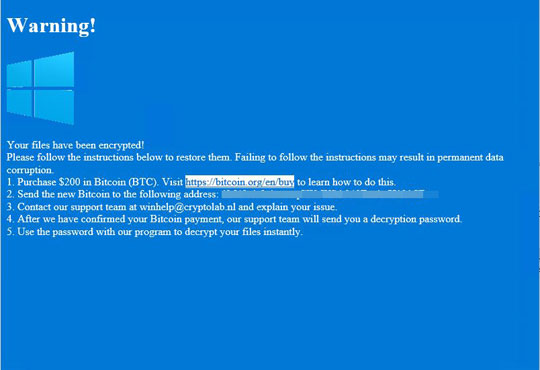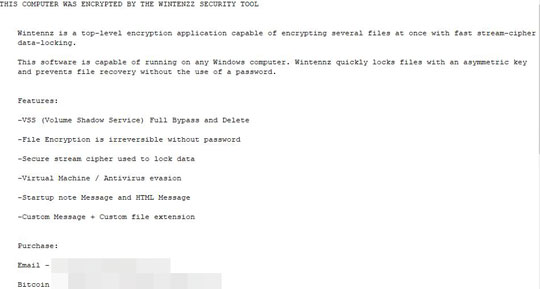Ransom.Win64.WINTENZ.THDABBA
Ransom:Win32/Genasom.DA!MTB (MICROSOFT); Trojan-Ransom.Win32.Gen.aauu (KASPERSKY)
Windows


Threat Type: Ransomware
Destructiveness: No
Encrypted: No
In the wild: Yes
OVERVIEW
This Ransomware arrives on a system as a file dropped by other malware or as a file downloaded unknowingly by users when visiting malicious sites.
It terminates itself if it detects it is being run in a virtual environment.
It encrypts files with specific file extensions. It encrypts files found in specific folders. It drops files as ransom note.
TECHNICAL DETAILS
Arrival Details
This Ransomware arrives on a system as a file dropped by other malware or as a file downloaded unknowingly by users when visiting malicious sites.
Installation
This Ransomware drops the following files:
- %User Startup%\winstrt10.exe - copy of itself
- %Public%\rstrt.bat - used to display ransom note
- %All Users Profile%\winfrce.bat - delete shadow copies
- %All Users Profile%\zwin.new
(Note: %User Startup% is the current user's Startup folder, which is usually C:\Windows\Profiles\{user name}\Start Menu\Programs\Startup on Windows 98 and ME, C:\WINNT\Profiles\{user name}\Start Menu\Programs\Startup on Windows NT, C:\Documents and Settings\{User name}\Start Menu\Programs\Startup on Windows 2003(32-bit), XP and 2000(32-bit), or C:\Users\{user name}\AppData\Roaming\Microsoft\Windows\Start Menu\Programs\Startup on Windows Vista, 7, 8, 8.1, 2008(64-bit), 2012(64-bit), 10(64-bit).. %Public% is the folder that serves as a repository of files or folders common to all users, which is usually C:\Users\Public in Windows Vista, 7, and 8.. %All Users Profile% is the common user's profile folder, which is usually C:\Documents and Settings\All Users on Windows 2000(32-bit), XP, and Server 2003(32-bit), or C:\ProgramData on Windows Vista, 7, 8, 8.1, 2008(64-bit), 2012(64-bit) and 10(64-bit). )
It adds the following processes:
- vssadmin.exe Delete Shadows /All /Quiet
- vssadmin.exe Resize ShadowStorage /For=C: /On=C: /MaxSize=320MB
- start "" "%User Startup%\STARTOPEN_ote.html"
- powershell get-wmiobject win32_computersystem|flmodel - to check if running in a virtual environment
- powershell-VerbrunasStart-process (get.location).Drive.Name
(Note: %User Startup% is the current user's Startup folder, which is usually C:\Windows\Profiles\{user name}\Start Menu\Programs\Startup on Windows 98 and ME, C:\WINNT\Profiles\{user name}\Start Menu\Programs\Startup on Windows NT, C:\Documents and Settings\{User name}\Start Menu\Programs\Startup on Windows 2003(32-bit), XP and 2000(32-bit), or C:\Users\{user name}\AppData\Roaming\Microsoft\Windows\Start Menu\Programs\Startup on Windows Vista, 7, 8, 8.1, 2008(64-bit), 2012(64-bit), 10(64-bit).)
Other Details
This Ransomware terminates itself if it detects it is being run in a virtual environment.
Ransomware Routine
This Ransomware encrypts files with the following extensions:
- docx
- doc
- txt
- xls
- xlsx
- odt
- ods
- ppt
- pptx
- png
- jpg
- mp3
- mp4
It encrypts files found in the following folders:
- %Application Data%\Microsoft\Internet Explorer\Quick Launch\User Pinned\TaskBar\
- %User Profile%\Music\
- %User Profile%\Downloads\
- %User Profile%\Videos\
- %User Profile%\Pictures\
- %User Profile%\Documents\
- %Desktop%\
(Note: %Application Data% is the current user's Application Data folder, which is usually C:\Documents and Settings\{user name}\Application Data on Windows 2000(32-bit), XP, and Server 2003(32-bit), or C:\Users\{user name}\AppData\Roaming on Windows Vista, 7, 8, 8.1, 2008(64-bit), 2012(64-bit) and 10(64-bit).. %User Profile% is the current user's profile folder, which is usually C:\Documents and Settings\{user name} on Windows 2000(32-bit), XP, and Server 2003(32-bit), or C:\Users\{user name} on Windows Vista, 7, 8, 8.1, 2008(64-bit), 2012(64-bit) and 10(64-bit).. %Desktop% is the current user's desktop, which is usually C:\Documents and Settings\{User Name}\Desktop on Windows 2000(32-bit), XP, and Server 2003(32-bit), or C:\Users\{user name}\Desktop on Windows Vista, 7, 8, 8.1, 2008(64-bit), 2012(64-bit) and 10(64-bit).)
It appends the following extension to the file name of the encrypted files:
- .wintenzz
It drops the following file(s) as ransom note:
- %User Startup%\STARTOPEN_ote.html

- %Desktop%\BUY_WINTENNZ.txt

SOLUTION
Step 1
Before doing any scans, Windows 7, Windows 8, Windows 8.1, and Windows 10 users must disable System Restore to allow full scanning of their computers.
Step 2
Note that not all files, folders, and registry keys and entries are installed on your computer during this malware's/spyware's/grayware's execution. This may be due to incomplete installation or other operating system conditions. If you do not find the same files/folders/registry information, please proceed to the next step.
Step 3
Restart in Safe Mode
Step 4
Search and delete these files
- %User Startup%\winstrt10.exe
- %Public%\rstrt.bat
- %All Users Profile%\winfrce.bat
- %All Users Profile%\zwin.new
- %User Startup%\STARTOPEN_ote.html
- %Desktop%\BUY_WINTENNZ.txt
Step 5
Restart in normal mode and scan your computer with your Trend Micro product for files detected as Ransom.Win64.WINTENZ.THDABBA. If the detected files have already been cleaned, deleted, or quarantined by your Trend Micro product, no further step is required. You may opt to simply delete the quarantined files. Please check this Knowledge Base page for more information.
Step 6
Restore encrypted files from backup.
Did this description help? Tell us how we did.

